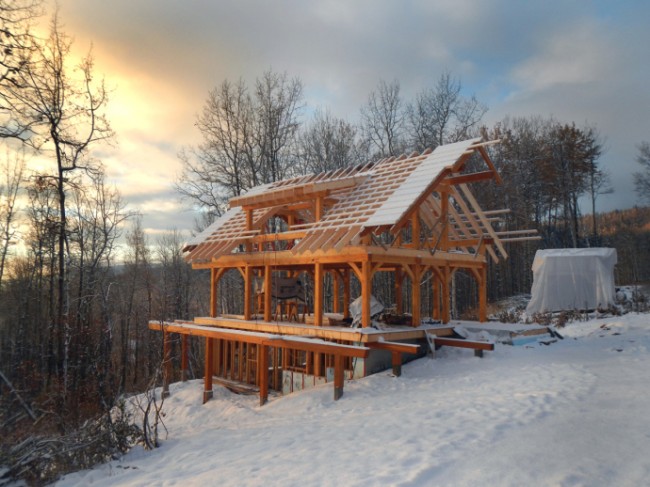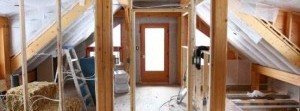
The other woman
“You should write a blog about the timbers,” Nick suggested excitedly some months ago.
Staring at the computer screen, I answered with a non-committal “mm-hmm… good idea” and continued typing. It still hasn’t happened. I’m not really sure why, but I could guess.
Hemlock beams after being shown some love with a brush sander.
Our timbers arrived in April. For Nick, it was love at first sight. We sanded them lovingly with a brush sander, which smoothed the surface while raising the grain, and finished them with natural Penofin Verde timber oil until they practically glowed.
In short, the timbers are gorgeous: tall, blond and slender. Once sanded, they have a smooth, gently undulating surface. I have watched Nick outside, while dinner grows cold on the table, caressing their silky surfaces. I see him gently tucking them under tarps at night. He goes out early, comes in late and always carries the faint smell of sawdust.
And this winner is… Penefin Verde natural! (far right)
I have come to see our timbers as the other woman.
Like most true loves, Nick’s meeting with our timbers was serendipitous. A friend told us about a lumber yard run by someone named Smith in the Hazelton area, an hour west of Smithers. We found a Smith with a mill, assumed it was a relative, and contacted him. Indeed, no relation, but Dennis Smith happened to be sitting on some hemlock he’d saved for a cabin. He’d chosen the best timbers for himself and let them dry two years. He’d never built the cabin and, with a little arm-twisting, was convinced to sell them to us.
The moment when it all comes together.
The timbers arrived in two loads from Hazelton: enough eight-by-eight and eight-by-10 hemlock posts and beams to fill our carport. Nick got to work back in April, cutting and notching the timbers, creating the mortise-and-tenon 3D jigsaw puzzle that would be our home.
We watched our friends Erin and Derek put up the main part of their frame at a work bee this summer and it struck me how many ways there are to build a timber frame: different types of wood, different finishes, different joinery and different designs. The style Derek chose involves entire floor-to-roof walls, called “bents,” assembled on the ground and raised—in their case—using ropes, pulleys and human power. A good, old-fashioned timber raising reminiscent of the settler days.
Unlike Derek and Erin’s, our house is layered like a wedding cake and went up in three stages, each floor supporting the one above. Our basement posts went up first, followed by a work bee to hoist the heavy beams into place (in the interior only, as the basement walls are concrete and stud framed). Then Nick built the main floor subfloor, put up the second layer of posts, and held another work bee to put up the beams—this one took a little longer, as there were more than twice as many beams on the main floor.
Crane power: not as much fun as a work bee, but it doesn’t drink all your beer after.
When it came to the upper floor, we decided we’d spare our friends the dizzying heights and precarious balancing and hired ourselves a crane. Our upper timbers were lifted into place a couple weeks ago and the tin roof is going on—finally, it truly looks like a house.
While writing this blog, I poked my head outside to see when Nick would be coming in for dinner. He was standing on the subfloor, staring blankly into space.
“Mon amour, j’aime le timber frame,” he called back, starry-eyed. “I keep trying to do work, but I can’t stop staring at it!”
I can’t disagree with him. I often find myself staring out the window, longing for the day that we’ll be able to live amongst those gorgeous timbers. Already I see them begin to weather, their darkening grain taking on an antique look. This is the house that’s been evolving in my mind for more than five years—only far more beautiful than I ever imagined.
In truth, I suppose we’re both smitten.
http://strawbaletales.wordpress.com/








